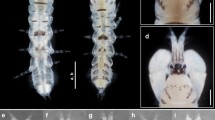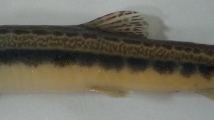Abstract
To date, specimens belonging to the genus Capitella Blainville, 1828 collected from Korean waters have been identified as C. capitata sensu Eisig, 1887 for over 35 years, depending almost totally on the description of Paik (Bull Korean Fish Soc 13:89–92, 1980), but consisted of the capitellid species examined in this study. Although the characteristics of 9 thoracic segments, thoracic chaetigers 1–7 with capillaries, and abdominal segments without branchiae or capillary chaetae correspond to C. capitata (Fabricius 1780), Korean capitellid specimens differ in a prostomium without deep dorsal depression, chaetigers 8–9 without neuropodial capillaries, chaetiger 8–9 of males without constriction, and high numbers of genital spines in males. Capitellid specimens from Korean waters resemble C. teleta Blake, Grassle & Eckelbarger, 2009 rather than C. capitata by the following morphological characteristics: presence of eyes, weak dorsal depression on prostomium, chaetigers 8–9 with neuropodial hooded hooks only, inflated chaetigers 8–9 of males, and 3–4 rows of teeth above the main fang. For precise identification of the Korean capitellid specimens, genetic analysis was performed, and the result revealed Capitella specimens of Korea genetically matched well with C. teleta of Ainan (0.4%) and Capitella spp. (0.2%) of Italy in partial cytochrome c oxidase subunit I (COI) gene comparison. Although there is little genetic difference between C. teleta from different areas, morphological differences in the shape of the prostomium and pygidium and the number of chaetae per fascicle suggest geographical variations in morphology caused by their adjacent environments. This result suggests the possibility of the existence of a species complex of C. teleta. In this study, genetic and morphological features of C. teleta of Korea are provided. In addition, a comprehensive comparison with previous records of C. capitata and C. teleta are conducted, and newly discovered intraspecific variations and the geographic distribution of C. teleta are discussed.




Similar content being viewed by others
References
Belan T (2003) Benthos abundance pattern and species composition in conditions of pollution in Amursky Bay (the Peter the Great Bay, the sea of Japan). Mar Pollut Bull 46:1111–1119. doi:10.1016/s0025-326x(03)00242-x
Blainville H (1828) Dictionnaire des Sciences naturelles, dans lequel on traite méthodiquement des différens êtres de la nature, considérés soit en eux-mêmes, d’après l’état actuel de nos connoissances, soit relativement a l’utilité qu’en peuvent retirer la médicine, l’agriculture, le commerce et les arts., vol 57. F.G. Levrault, Strasbourg
Blake J (2000) Chapter 4. Family Capitellidae Grube, 1862. In: Blake JA, Hilbig B, Scott PV (eds). Taxonomic Atlas of the Santa Maria Basin and Western Santa Barbara Channel. Vol. 7. Annelida Part 4. Polychaeta: Flabelligeridae to Sternaspidae. Santa Barbara Museum of Natural History, pp 47–96
Blake J (2009) Redescription of Capitella capitata (Fabricius) from West Greenland and designation of a neotype (Polychaeta, Capitellidae). Zoosymposia 2:55–80. doi:10.11646/zoosymposia.2.1.7
Blake J, Grassle J, Eckelbarger K (2009) Capitella teleta, a new species designation for the opportunistic and experimental Capitella sp. I, with a review of the literature for confirmed records. Zoosymposia 2:25–53. doi:10.11646/zoosymposia.2.1.6
Bosc LAG (1802) Histoire naturelle des vers contenant leur description et leurs moeurs, avec figures dessinées d’après nature. De l’imprimerie de Guilleminet, Paris, chez Deterville. doi:10.5962/bhl.title.51349
Carr CM, Hardy SM, Brown TM, Macdonald TA, Hebert PD (2011) A tri-oceanic perspective: DNA barcoding reveals geographic structure and cryptic diversity in Canadian polychaetes. Plos One e22232. doi:10.1371/journal.pone.0022232
Dean HK (2001) Capitellidae (Annelida : Polychaeta) from the Pacific coast of Costa Rica. Rev Biol Trop 49:69–84. doi:10.15517/rbt.v49i2.26293
Eckelbarger KJ, Grassle JP (1983) Ultrastructural differences in the eggs and ovarian follicle cells of Capitella (Polychaeta) sibling species. Biol Bull 165:379–393. doi:10.2307/1541203
Eckelbarger KJ, Grassle JP (1987) Interspecific variation in genital spine, sperm, and larval morphology in six sibling species of Capitella. Bull Biol Soc Wash 62–76
Eisig H (1887) Monographie der Capitelliden des Golfes von Neapel vol 16. Fauna und Flora des Golfes von Neapel, Italy. doi:10.5962/bhl.title.11542
Fabricius O (1780) Fauna Groenlandica systematice sistens animalia Groenlandiae occidentalis hactenus indagata, quod nomen specificium, triviale, vernaculumque. Hafniae et Lipsiae, Copenhagen. doi:10.5962/bhl.title.13489
Fauchald K (1977) The polychaete worms: definitions and keys to the orders, families and genera. Natural History Museum of Los Angeles County, Los Angeles
Geller J, Meyer C, Parker M, Hawk H (2013) Redesign of PCR primers for mitochondrial cytochrome c oxidase subunit I for marine invertebrates and application in all-taxa biotic surveys. Mol Ecol Resour 13:851–861. doi:10.1111/1755-0998.12138
Glasby CJ, Wei NWV, Gibb KS (2013) Cryptic species of Nereididae (Annelida : Polychaeta) on Australian coral reefs. Invertebr Syst 27:245–264. doi:10.1071/Is12031
Grassle JP, Grassle JF (1976) Sibling species in the marine pollution indicator Capitella (Polychaeta). Science 192:567–569. doi:10.1126/science.1257794
Grassle JF, Grassle JP (1977) Temporal adaptations in sibling species of Capitella. In: Ecology of marine benthos. University of South Carolina Press, Columbia, pp 177–189
Grube AE (1862) Noch ein Wort über die Capitellen und ihre Stelle im Systeme der Anneliden. Archiv für Naturgeschichte, Berlin 28:366–378
Hartman O (1947) Polychaetous annelids. Part VII. Capitellidae. Allan Hancock Pacific Expeditions, California 10:391–481
Hartman O (1959) Capitellidae and Nereidae (marine annelids) from the Gulf side of Florida, with a review of freshwater Nereidae. B Mar Sci 9:153–168
Hebert PD, Cywinska A, Ball SL (2003) Biological identifications through DNA barcodes. Proc R Soc Lond B 270:313–321. doi:10.1098/rspb.2002.2218
Hilliard J, Hajduk M, Schulze A (2016) Species delineation in the Capitella species complex (Annelida: Capitellidae): geographic and genetic variation in the northern Gulf of Mexico. Invertebr Biol 135:415–422. doi:10.1111/ivb.12152
Hutchings P (1998) Biodiversity and functioning of polychaetes in benthic sediments. Biodivers Conserv 7:1133–1145
Kimura M (1980) A simple method for estimating evolutionary rates of base substitutions through comparative studies of nucleotide sequences. J Mol Evol 16:111–120. doi:10.1007/bf01731581
Magalhães WF, Bailey-Brock JH (2012) Capitellidae Grube, 1862 (Annelida: Polychaeta) from the Hawaiian islands with description of two new species. Zootaxa 3581:1–52
Mendez N, Linke-Gamenick I, Forbes VE (2000) Variability in reproductive mode and larval development within the Capitella capitata species complex. Invertebr Reprod Dev 38:131–142. doi:10.1080/07924259.2000.9652448
Navajas M, Navia D (2010) DNA-based methods for eriophyid mite studies: review, critical aspects, prospects and challenges. Exp Appl Acarol 51:257–271. doi:10.1007/s10493-009-9301-z
Nishino YI, Ohwada T (1991) A sonication technique to remove the hoods of hooded hooks for the SEM observation of polychaete chaeta. B Mar Sci 48:242–245
Nygren A, Eklof J, Pleijel F (2009) Arctic-boreal sibling species of Paranaitis (Polychaeta, Phyllodocidae). Mar Biol Res 5:315–327. doi:10.1080/17451000802441301
Paik EI (1980) New records of three benthic polychaetous annelid species in Korea. Bull Korean Fish Soc 13:89–92
Pearson T, Rosenberg R (1978) Macrobenthic succession in relation to organic enrichment and pollution of the marine environment. Oceanogr Mar Biol Ann Rev 16:229–311
Read G (2016) Polychaeta. Accessed through: World Register of Marine Species. Available from http://www.marinespecies.org/aphia.php?p=taxdetails&id=883. Accessed 21 October 2016
Rouse GW, Pleijel F (2006) Annelid phylogeny and systematics. In Rouse GW, Pleijel F (ed) Reproductive biology and phylogeny of Annelida. Enfield: Science Publishers, pp 3–21
Salazar-Silva P, Carrera-Parra LF (2014) Revision of Lepidonopsis humilis (Augener, 1922) and description of L. barnichae sp. nov. (Annelida: Polychaeta: Polynoidae) based upon morphological and molecular characters. Zootaxa 3790:555–566. doi:10.11646/zootaxa.3790.4.4
Sanders HL, Grassle JF, Hampson GR, Morse LS, Garner-Price S, Jones CC (1980) Anatomy of an oil spill: long-term effects from the grounding of the barge Florida off West Falmouth, Massachusetts. J Mar Res 38:265–380
Sato-Okoshi W, Abe H (2012) Morphological and molecular sequence analysis of the harmful shell boring species of Polydora (Polychaeta: Spionidae) from Japan and Australia. Aquaculture 368:40–47. doi:10.1016/j.aquaculture.2012.08.046
Southern R (1914) Clare Island survey. Archiannelida and Polychaeta. Proc R Ir Acad 31:1–160
Tamura K, Nei M (1993) Estimation of the number of nucleotide substitutions in the control region of mitochondrial DNA in humans and chimpanzees. Mol Biol Evol 10:512–526. doi:10.1093/oxfordjournals.molbev.a040023
Tamura K, Stecher G, Peterson D, Filipski A, Kumar S (2013) MEGA6: molecular evolutionary genetics analysis version 6.0. Mol Biol Evol. doi:10.1093/molbev/mst197
Tomioka S, Kondoh T, Sato-Okoshi W, Ito K, Kakui K, Kajihara H (2016) Cosmopolitan or cryptic species? A case study of Capitella teleta (Annelida: Capitellidae). Zool Sci 33:545–554. doi:10.2108/zs160059
Tsutsumi H (1987) Population dynamics of Capitella capitata (Polychaeta; Capitellidae) in an organically polluted cove. Mar Ecol Prog Ser 36:139–149. doi:10.3354/meps036139
Wu B, Qian P, Zhang S (1988) Morphology, reproduction, ecology and isoenzyme electrophoresis of Capitella Complex in Qingdao. Acta Oceanol Sin 7:442–458
Acknowledgements
We would like to thank the anonymous reviewers and Dr. Dieter Fiege who made constructive and invaluable suggestions and comments. This study was a part of the project titled ‘Long-term change of structure and function in marine ecosystems of Korea’, funded by the Ministry of Oceans and Fisheries, Korea. This work was supported by the National Marine Biodiversity Institute Research Program (2016 M00300), funded by the National Marine Biodiversity Institute of Korea (MABIK).
Author information
Authors and Affiliations
Corresponding author
Additional information
Communicated by D. Fiege
This article is registered in ZooBank under urn:lsid:zoobank.org:pub:8DB7D765-5DF2-4DCA-9630-47DCF81AF28A
Rights and permissions
About this article
Cite this article
Jeong, MK., Wi, J.H. & Suh, HL. A reassessment of Capitella species (Polychaeta: Capitellidae) from Korean coastal waters, with morphological and molecular evidence. Mar Biodiv 48, 1969–1978 (2018). https://doi.org/10.1007/s12526-017-0707-2
Received:
Revised:
Accepted:
Published:
Issue Date:
DOI: https://doi.org/10.1007/s12526-017-0707-2




